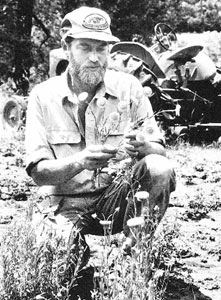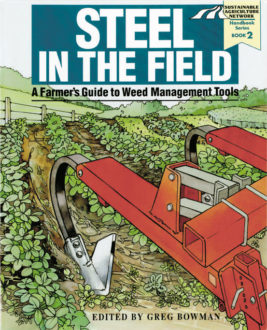
Horticultural Crops: The Farmers
Flaming, Close Cultivation, Cover Crops Control Wisconsin Vegetable Weeds
Rich deWilde
Viroqua, Wisconsin
- 40 acres
- cover crops: oats, winter peas, hairy vetch, red clover
- silty loam soils
- 30-inch bed plantings, single or double row per bed
- fresh-market vegetables: salad greens, onions, garlic, snap beans, root crops
- cut flowers
Weed management highlights
Strategies: crop rotation (planting location, time of season)... cover crops to break weed cycles... mechanical and thermal controls... hand-hoeing... stale seedbed with tillage and flaming
Tools: toolbar flamer... hand-held flamer... frame combination weeder... rotary hoe... light disk
Insight: 'I've learned the importance of faithful rotations. Two years of salad greens set me up for a chickweed explosion in September of the third year, so I seeded an extra-thick stand of oats and peas. It suppressed the chickweed, winterkilled and broke down easily the next spring.' - Rich de Wilde
Rich de Wilde plants, nurtures and harvests 40 acres of specialty greens and vegetables, emphasizing novel varieties and crop diversity. He's as deliberate and innovative in managing weeds with steel and flame as he's been in helping to build demand for premium quality organic produce in the Upper Midwest.
That doesn't translate into a lot of high-priced machinery or commercial technology. Instead it means he focuses his management skills on integrating shallow tillage, cover crops, stale-seedbed planting and crop rotation with precision cultivation and aggressive, carefully delivered and well-timed flaming. By successfully lowering weed pressure each year that he farms a field, he cuts costs and labor devoted to weed management - adding dollars to his bottom line.
De Wilde follows the advice of his tobacco-farming neighbors. 'They said to never let weeds go to seed. We've stuck to that rule for the 11 years we've been here. And we've noticed that our fields have gotten incredibly cleaner. There's a lot less hand-weeding to do now.'
He plugs a clean hand-weeding into his budget at $360 per acre - 60 hours at $6 per hour. It's a treatment of last resort, but one that's justified because of its immediate and long-term benefits. That striking cost figure helps him critically evaluate other approaches that meet his personal goal - and his organic certification mandate - of a no-herbicide system. It also motivates his early season management.
Another piece of his organic approach is to optimize a broad range of nutrient levels based on lab tests of soil samples. Optimum fertility tied to crop needs gives crops early vigor to outcompete weeds. This strategy is especially important for the direct-seeding he finds most efficient for small-seeded crops. De Wilde believes that his attention to applying calcium, sulfur and trace minerals has added to the crops' advantage.
He uses a moldboard plow 4 to 6 inches deep every two or three years of the crop rotation to incorporate a rank cover crop of rye, hairy vetch and red clover, but chisel plows 8 inches deep for primary tillage whenever possible. Limiting pre-plant tillage to the top several inches minimizes how many weed seeds are stimulated by movement and light. When the first flush of weeds sprouts in a week or so, he makes a pass with a combination of a light disk or cultipacker and steel drag. He repeats the pass if he has to wait for a second flush to emerge.
His frequent but low-impact tillage sequences do not cause surface compaction of his silt loam soils. He subsoils 18 to 20 inches deep in alternate years to maintain excellent percolation and root-zone looseness.
Within this context of intensive weed suppression, de Wilde works with flaming and cultivation to kill small weeds. Applying flame broadcast - across the entire soil surface - just before the crops emerge gives them a tremendous advantage. De Wilde uses a toolbar mounted propane unit with four liquid gas, self vaporizing burners mounted on an old cultivator frame. He can set the burners to provide a solid wall of flame, or angle two burners per row to hit only at the base of crop plants once heat-tolerant crops are mature enough. He needs only a 9/16 -inch wrench to adjust pivot attachments that connect the burners to round pipe standards.
Preemergent flaming is especially effective for slow germinating crops such as onions, parsnips, spring carrots and larkspur, a flower which he plants for fresh cut sales at farmers markets. Weeds are so problematic on super-slow developing parsnips, de Wilde says, that he wouldn't consider raising them without a flamer.
To cut the interval between flaming and crop emergence as short as possible, de Wilde uses market garden expert Eliot Coleman's 'window method.' A pane of glass placed over the seedrow causes a crop to germinate about two days early - usually enough time to check the weather and set the last 'safe' time to flame the row before the tender crop seedlings emerge.
Flaming after crops emerge is an option that demands carefully adjusted tools and a more skilled operator. De Wilde recalls a field of garlic where patches of purslane in 6-inch rosettes became a problem within the row. He had already cultivated, but the rolled-in soil had failed to stifle the succulent weeds. Without a span of hot, dry weather, de Wilde knew that even hand-pulled purslane turned roots-up could survive to haunt him again.
He cranked up pressure on his gas regulator to 45 psi (compared with his usual pressure of 35 psi) and slowed down tractor speed to about 2.5 miles per hour (compared with his top flaming speed of 4.5 mph). Bulb reserves helped the singed garlic leaves to rejuvenate. The shallow-rooted purslane died. Other growers report purslane is nearly immune to flaming, and also often survives sweep cultivating.
Much like the postemergent use of a rotary hoe, what the operator sees happening during flaming is not the final result, i.e., crop damage isn't as severe as it looks. Unless he's confident of what flaming will do in a particular situation, de Wilde spot tests with a hand held burner (one with a flame equivalent to his row crop flamer) before he treats a whole field. Determining on-the-spot if weeds will die and the crop will live is a critical acquired skill. (See 'Hot Tips For Flame Weeding')
Any flame contact on the growing point or leaves of a crop is likely to set back growth. Growers get the benefit of flaming without losing crop productivity by applying it via stale seedbed, with crop shields or with water-spray shielding.
De Wilde recalls with chagrin a learning moment with a test patch in a field of potatoes early in his flaming career. Only a few green sprouts had emerged, and trauma to the young leaves within the flamed area seemed too severe to him to withstand the treatment. When he returned 10 days later, the flamed part of the field had vigorous, weed-free spuds. The rest of the acre had to be hand-weeded. His misreading of the leaves cost him many hours of labor. Potatoes are unusually vigorous in compensating regrowth after leaf loss thanks to the stored energy in the 'seed' tuber.
The staggered plantings of a diversified vegetable farm require de Wilde to manage weeds under many different situations. While he doesn't have the degree of control that flood irrigation gives dryland growers, he has found that flaming works best in the hottest parts of the hottest days of summer. He hits this window when he puts in fall carrots. That sequence is soil prep (chisel plow and disking), a week's wait for weed-seed germination, flaming to eliminate sprouted weeds, then seeding with the least possible soil disturbance.
'Propane is nice and clean - in the field, in our greenhouse furnaces and in our forklift,' de Wilde says. 'I treat it with great respect, and I've had no problems safety-wise. I'm still working on my management and my nerve, but that's about knowing when the flame is too hot or too close for my crops.'
He calculates that flame weeding costs him $10 to $12 per acre for fuel, labor and equipment. A forklift-type LP gas cylinder covers about 2.5 acres. At 2.5 mph, he can flame-weed onions (double rows on 30-inch beds) at a rate of a half-acre per hour.
When he needs gentle cultivation for young small seeded crops, de Wilde turns to a vintage Italian combination frame weeder he found at a Michigan used-machinery yard. Central to the weeder's precision is a frame that rides on the ground. De Wilde replaced its skid runners with 4-inch wheels. Tooling includes vegetable side knives, 7-inch sweeps and small 4-inch cutaway disks. De Wilde added curved round metal fingers that run in front of the disks at ground level to nudge tiny plants to an upright position, out of reach of the disks. He adjusts the disk to run 0.50 to 0.75 inches deep and about 2 inches from a row of plants at least 2 inches tall. Driving this tool is a demanding job. 'It takes a really good person who's really awake,' de Wilde reports.
'I set the disks at a slight angle away from the row so they just scratch out about a one-inch band next to the row,' de Wilde explains. 'The side-knives come down the middle of that furrow so that the trailing arms smooth out the outside edge.' He keeps the knives sharp and runs them flat and shallow to minimize soil movement into the row.
This is a precision, clean-tillage tool that depends on the flat surface created by a smooth roller pulled over the rows after planting in a separate pass. The uniform flatness puts the growing points of each weed closer to the same level, increasing the effectiveness of the knives. 'When rain keeps the roller out, it's a nightmare to cultivate,' de Wilde reports. When things go well, the roller/combination-weeder sequence cuts hand-weeding in half.
But this farmer wasn't satisfied. To beef up his anti-weed tool squad, de Wilde next fabricated an extendable, belly-mount, two-row cultivator mounted on an International Harvester (IH) Super A. The tractor's offset opening ahead of the driver gives an unobstructed, straight-ahead view of tools working the soil.
His Super A is for cultivating - period. Many commercial market-farmers have one or several tractors just for cultivating, often with the same implement permanently mounted and adjusted, to get the right steel in the field at the right time. He also outfits the tractor with a conventional low-residue, multiple-sweep cultivator with straight shanks and 2-inch shovels. In '96 he bought an IH 140 offset tractor and married it to his Italian cultivator.
De Wilde knows weeds will always be around, daring farmers to manage them. By containing weed pressure through preventing new weed seed whenever possible and suppressing weed competition through stale seedbed preparation, de Wilde is confident that his close-in cultivating and finely-tuned flaming will keep the stragglers in check.
